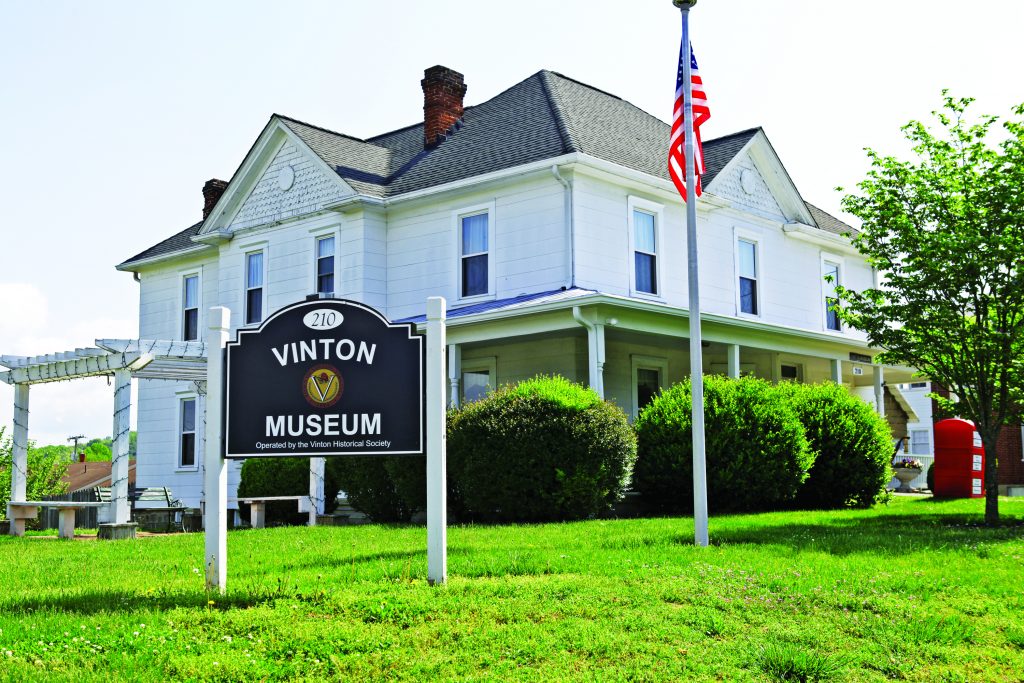
By Vickie Holt
In 1984, a group of Vinton citizens came together with a common passion and a common goal: researching and documenting items of historical relevance, with a proclivity toward items pertaining to the town of Vinton. Among that original group were Margaret Wood, Catharine Burkholder, June Eanes, Madeline Forbes, Frances Coleman, Frank Craddock, and Montague Swain. This group had dreams of creating an official Vinton Historical Society, but such an undertaking would require resources.
To promote their efforts, and to raise the money they needed to begin an official organization, Irma Mosely and Madeline Forbes compiled a hundred-year history of Vinton and published it in a 205-page book called “Vinton History 1884 – 1984”. The book was released in 1984, the same year that Vinton celebrated its Centennial. It would be five more years, however, before the Vinton Historical Society found a home.
The home of Mary Upson Williams, to be precise. Mary’s parents, J.H. and Amelia Upson, had moved to Vinton in 1889, just five years after Vinton became Vinton. Once settled, the couple opened a general store on the corner of Maple and Lee Avenues. In 1899, the Upsons purchased two lots from J.W Vineyard, and by 1906, had built the ten-room home now located at 210 East Jackson Avenue.
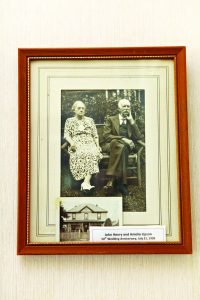 Just a few short years before her passing, Mary requested that her family home be donated to the Town of Vinton to be used for public or municipal purposes. In 1989, just four years before Mary passed away, her wishes were honored in the most fitting of ways. A house that had been standing for almost all of Vinton’s history became the Vinton History Museum.
Just a few short years before her passing, Mary requested that her family home be donated to the Town of Vinton to be used for public or municipal purposes. In 1989, just four years before Mary passed away, her wishes were honored in the most fitting of ways. A house that had been standing for almost all of Vinton’s history became the Vinton History Museum.
The museum is a treasure trove of historical items and displays, arranged by theme throughout each room. Just inside the front door, on a wall in the foyer, visitors will find an amazing, framed photograph of J.H. and Amelia Upson, celebrating their fiftieth wedding anniversary in 1938.
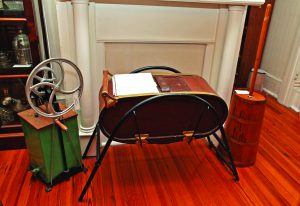 A quick trip through the information office, and visitors will be in what was the Upson’s dining room. Here, a glass case features temporary displays, such as the current collection of antique spring hats. The rest of the room is filled with other historic items, including examples of three different designs of butter churns.
A quick trip through the information office, and visitors will be in what was the Upson’s dining room. Here, a glass case features temporary displays, such as the current collection of antique spring hats. The rest of the room is filled with other historic items, including examples of three different designs of butter churns.
Just off the dining room is the kitchen, which appropriately contains many historic items that might have appeared in everyone’s kitchen a century or more in the past.
Across the hall on the first floor are two more rooms, one containing an amazing array of early entertainment devices, such as radios, televisions, phonographs, and even a working cylinder phonograph!
 The other room pays homage to Gish’s Mill, the name the area went by before it was officially established as Vinton. The name derives from the Gish family, who settled in the area in the late 1700’s and built a grist mill on Glade Creek. The room also celebrates education and church history in Vinton. Out in the hallway, visitors will find military displays, honoring those who fought for our country.
The other room pays homage to Gish’s Mill, the name the area went by before it was officially established as Vinton. The name derives from the Gish family, who settled in the area in the late 1700’s and built a grist mill on Glade Creek. The room also celebrates education and church history in Vinton. Out in the hallway, visitors will find military displays, honoring those who fought for our country.
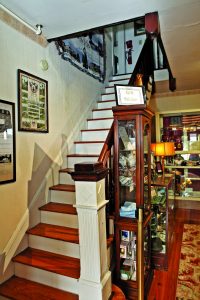 Among these displays is also the beautiful stairway leading to the second-floor exhibits. Later this year, the Society hopes to launch a project to install an elevator on the side of the old Upson house. As Judy explains, many elderly or disabled visitors, and sometimes even children, have trouble climbing the stairs to visit the second-floor exhibits. She also admits that many of the staff and volunteers face the same problem.
Among these displays is also the beautiful stairway leading to the second-floor exhibits. Later this year, the Society hopes to launch a project to install an elevator on the side of the old Upson house. As Judy explains, many elderly or disabled visitors, and sometimes even children, have trouble climbing the stairs to visit the second-floor exhibits. She also admits that many of the staff and volunteers face the same problem.
Upstairs, there is a business and occupation room, a vintage tool room, and two bedrooms. The child’s bedroom features clothing, toys, and other vintage items that our parents, grandparents, great-grandparents, and even great-great grandparents would have used when they were children. 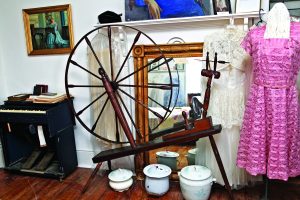 Likewise, the adult bedroom features vintage clothing, an antique bed, and other items that may have been used in the bedrooms of Vinton’s earliest citizens, including a magnificent spinning wheel.
Likewise, the adult bedroom features vintage clothing, an antique bed, and other items that may have been used in the bedrooms of Vinton’s earliest citizens, including a magnificent spinning wheel.
The stairway railings in the hallway are draped with vintage quilts, all of which have been appraised to identify age, design, and value. In the corner rests a stain glass pane that once hung in Vinton Baptist Church.
That leaves just a final room upstairs, and this room is currently being used for a very exciting project. Many in Vinton may recall having to attend class in the school building on Gus Nicks Boulevard. Before the new high school was built on Washington Avenue, this building served as Vinton’s high school. After the Washington Avenue school was built, it became Vinton’s middle school, but it still housed a tradition that stretched from the 1930’s to the 1970’s.
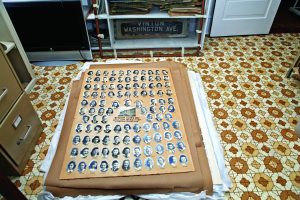 Lining the halls of the building were large glass frames, each containing an arrangement of photos representing that year’s graduating class. When the building was sold to the developer who eventually remodeled it for housing, the framed collections were handed over to the Vinton Historical Society. (The historic William Byrd graduating class photo collections, waiting to be digitized and stored for preservation)
Lining the halls of the building were large glass frames, each containing an arrangement of photos representing that year’s graduating class. When the building was sold to the developer who eventually remodeled it for housing, the framed collections were handed over to the Vinton Historical Society. (The historic William Byrd graduating class photo collections, waiting to be digitized and stored for preservation)
The photo sheets have all been remove from their heavy, 45” x 35” frames, and over the next several months, each collection will be digitized and added to the website as the museum’s very first digital offering!
Historical Society Treasurer, Debbie Pitts, has taken the lead on the project. She tells us the images will become available for viewing on the website at www.vintonhistorymuseum.org. As for the original sheets, they will be carefully stored for preservation. Unfortunately, the museum doesn’t have the space to continue displaying all the frames, and the concern is that displaying the unframed sheets could result in them being damaged. Displayed or digitized, this is a magnificent piece of Vinton history, and a very special memory for many who will find either themselves or their family members among the digitized images.
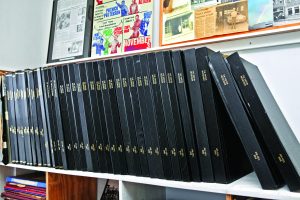 The Vinton Historical Society and Museum, however, is not just about preserving historic or vintage items. They are also a repository for historic information! Upon entering the museum, visitors can see a very busy-looking room directly to the left of the foyer. This is Information Central, where the walls are lined with shelves containing books, catalogs, files, notebooks, and folders chock full of newspaper clippings, information about, and photos of Vinton families, businesses, events, development, and more! The museum staff and volunteers are very knowledgeable and eager to help when someone needs historic information for genealogy, research, or curiosity.
The Vinton Historical Society and Museum, however, is not just about preserving historic or vintage items. They are also a repository for historic information! Upon entering the museum, visitors can see a very busy-looking room directly to the left of the foyer. This is Information Central, where the walls are lined with shelves containing books, catalogs, files, notebooks, and folders chock full of newspaper clippings, information about, and photos of Vinton families, businesses, events, development, and more! The museum staff and volunteers are very knowledgeable and eager to help when someone needs historic information for genealogy, research, or curiosity.
Museum Executive Director, Judy Cunningham tells an incredible story about a high school ring that was lost in the late seventies/early eighties after having been accidentally left behind at a rest stop on I81. Michele Ann Weiss (now Walker) returned to the rest stop to retrieve her ring, but by then it was already gone.
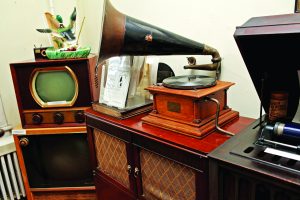 As it turned out, a woman named Velma Merrifield had found the ring, but the information age was still a few decades away. She didn’t know how to return it, so it remained put away with her family for decades. Her daughter-in-law, Sue Merrifield, recently discovered the ring and thought she’d give Facebook a try. She posted a picture of the ring, along with the graduation year, school name, and initials.
As it turned out, a woman named Velma Merrifield had found the ring, but the information age was still a few decades away. She didn’t know how to return it, so it remained put away with her family for decades. Her daughter-in-law, Sue Merrifield, recently discovered the ring and thought she’d give Facebook a try. She posted a picture of the ring, along with the graduation year, school name, and initials.
The family then located some William Byrd Alumni groups, which led her eventually to the Vinton Historical Society. Though the Museum houses and extensive collection of William Byrd year books, they were missing the critical 1977 volume. Fellow 1977 Alumni, Karen Jackson, also joined the search, keeping the Facebook exchanges going.
 As fate would have it, a patron donated the much-needed 1977 volume of the William Byrd yearbook at this point in the search. Several girls’ names matched the initials, and through contact and elimination, the staff at the museum was finally able to identify the owner of the ring – Michele Ann Weiss.
As fate would have it, a patron donated the much-needed 1977 volume of the William Byrd yearbook at this point in the search. Several girls’ names matched the initials, and through contact and elimination, the staff at the museum was finally able to identify the owner of the ring – Michele Ann Weiss.
Contact information for Michele’s mother was eventually obtained through Facebook messaging, and through her mother, Michele was finally reached, and the ring was posted swiftly to her home in Indiana!
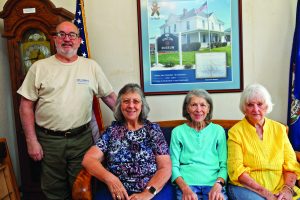 Teamwork and cooperation helped to solve a forty-five-year-old mystery, and teamwork is most definitely at the heart of operations for the Vinton History Museum. The official staff are Randy Layman President), Denny Dickens (Vice- President), Marie Bell (Secretary), Debbie Pitts (Treasurer), Judy Cunningham (Executive Director), Mary Beth Layman (Program Director), Jan Dickens, Ann Hewitt, Judy Kelley, JoAnn Newman, Darlene Richardson (Directors), and Julie Tucei (Town of Vinton representative). However, the museum couldn’t operate without its army of volunteers! Currently, about twenty volunteers help to catalog items, perform research, work on projects, and just generally help out. Pictured above, left to right: Randy Layman (President), Debbie Pitts (Treasurer), Judy Cunningham (Executive Director), and Jo Ann Newman (Director).
Teamwork and cooperation helped to solve a forty-five-year-old mystery, and teamwork is most definitely at the heart of operations for the Vinton History Museum. The official staff are Randy Layman President), Denny Dickens (Vice- President), Marie Bell (Secretary), Debbie Pitts (Treasurer), Judy Cunningham (Executive Director), Mary Beth Layman (Program Director), Jan Dickens, Ann Hewitt, Judy Kelley, JoAnn Newman, Darlene Richardson (Directors), and Julie Tucei (Town of Vinton representative). However, the museum couldn’t operate without its army of volunteers! Currently, about twenty volunteers help to catalog items, perform research, work on projects, and just generally help out. Pictured above, left to right: Randy Layman (President), Debbie Pitts (Treasurer), Judy Cunningham (Executive Director), and Jo Ann Newman (Director).
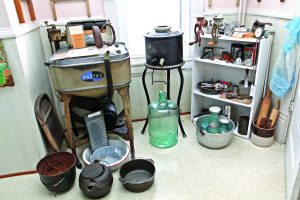 Judy Cunningham tells us they also get additional help in the form of those performing community service, as well as students fulfilling high school and college internships. If anyone wishes to volunteer, they may indicate their interest on the website by clicking the Help Out navigation link at the top of the page.
Judy Cunningham tells us they also get additional help in the form of those performing community service, as well as students fulfilling high school and college internships. If anyone wishes to volunteer, they may indicate their interest on the website by clicking the Help Out navigation link at the top of the page.
Everyone is encouraged to visit the webpage regularly to keep abreast of new projects, exhibitions, and events, as well as opportunities to become part of history by helping the organization whose mission is to gather and protect it.
The museum is open Monday, Wednesday, Friday, an the first Saturday of each month from 10:00am – 2:00pm. For more formation about the Vinton Historical Society & Museum, to make an inquiry, or to help by volunteering or making a donation, visit online at www.vintonhistorymuseum.org. You can also follow on Facebook at Vinton-History-Museum.
Vinton Historical Society & Museum
www.VintonHistoryMuseum.org
